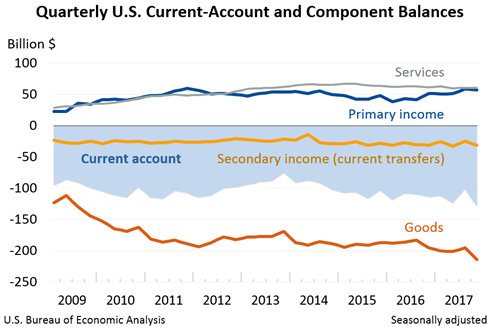Talking Points:
- US Current Account widened to $128.2 in the fourth quarter of 2017; the Q3 deficit was revised up to $101.5 from $100.6b
- Imports at +$33.1b offset exports at +14.2 billion
- Deficit fits into overarching protectionism theme; unlikely to influence Fed at FOMC today
- DXY trades lower ahead of rate decision
- See the DailyFX Economic Calendar for upcoming economic data and for a schedule of live coverage see the DailyFX Webinar Calendar.
Current Account Deficit
In the fourth quarter of 2017, the Bureau of Economic Analysis (BEA) reported that the current account deficit rose to $128.2 billion. In addition, the third quarter deficit at $100.6 billion was revised higher to $101.5b. The deficit accounted for 2.6% of current gross domestic product (GDP) in the fourth quarter up from 2.1% in the previous quarter.
The $26.7 billion increase in the current account deficit was mostly attributed to an increase in goods and secondary income deficit and a decrease in the surplus on primary income.
Exports of goods and services and income receipts rose by $16.6 billion to $878.8 billion. Here are some key trade takeaways:
- Goods exports: +$14.2 billion, $400.7 billion total (attributed to an increase in industrial supplies and materials)
- Goods imports: +$33.1 billion, $614.9 billion total (attributed to an increase in industrial supplies and consumer goods)
- Primary income receipts:+$6.0 billion, $243.9 billion total, (attributed to an increase in direct investment income and in portfolio investment income)
- Primary income payments:+$7.3 billion, $186.7 billion total, (attributed to an increase in direct investment income)
- Secondary income receipts:-$5.9 billion, $35.3 billion total, (attributed to decrease in US government transfers)
As A Refresher:
The current account represents one half of the balance of payments. The other half is the capital account. The current account measures imports and exports of goods and services,net income from abroad (payments received from investments abroad – payments made), and net current transfers (including foreign aid). A positive current account balance indicates that the nation is a net lender to the rest of the world whereas a negative current account balance indicates that the nation a net borrower.
Here is a visual of the current account and component balances provided by the BEA:

If you’re looking to improve your trading strategy check out our longer-term forecasts for the US Dollar, Euro, British Pound and more with the DailyFX Trading Guides.
It is unlikely that the Federal Reserve will mention the widening deficit at the Federal Open Market Committee later today. And it is also unlikely that it will interfere with their projected 25 basis-point rate hike. Although, this certainly fits in with the theme of protectionism and the potential for a trade war. This is something to keep in mind as President Trump moves forward with his agenda on tariffs, trade renegotiations (like the North America Free Trade Agreement), and more recently China’s alleged steel dumping.
Here is a summary of today’s trade print:
- USD Advance Goods Trade Balance (4Q): -$128.2b versus -$125.0b expected, from -$101.5b (revised higher from -$100.6b)
Chart 1: DXY Index 15-minute Chart (March 19 - 21)

Immediately following the data, the US Dollar Index nudged slightly lower. But since the start of the week, DXY has traded lower from 90.45. Market participants will be watching closely the Fed’s dot plot, forecast, and comments from Chair Jerome Powell later today.
--- Written by Dylan Jusino, DailyFX Research







